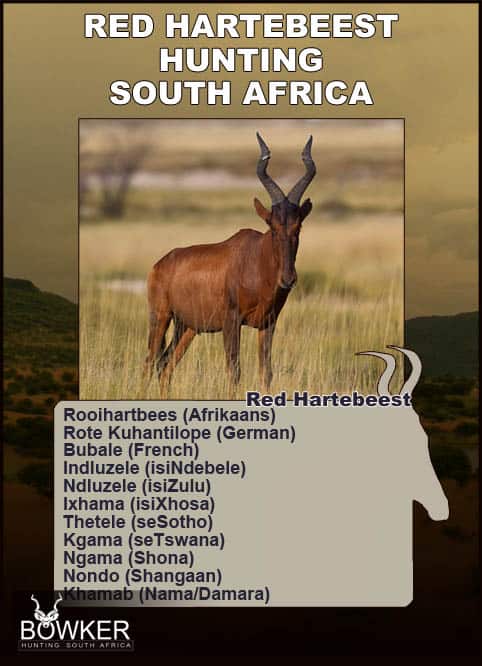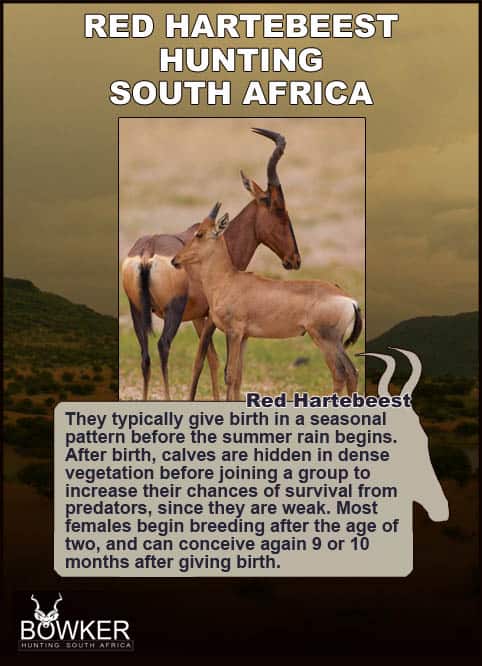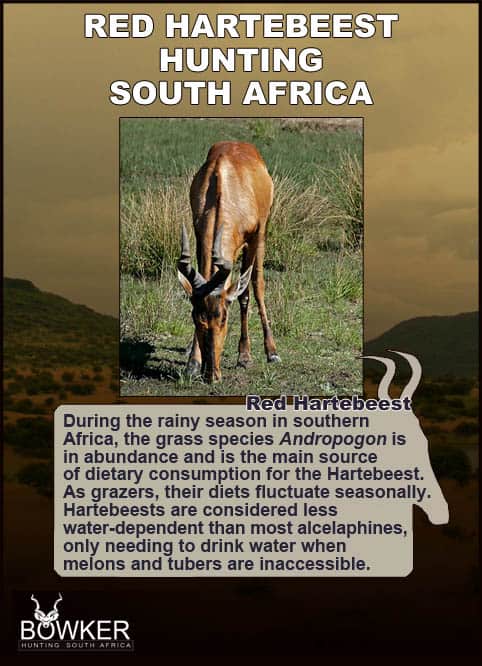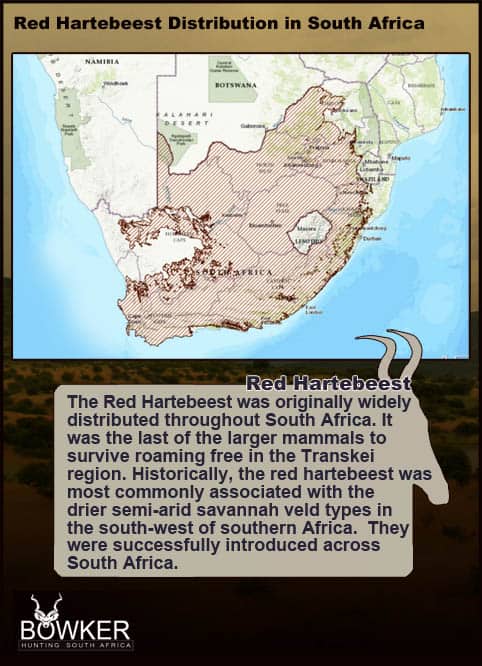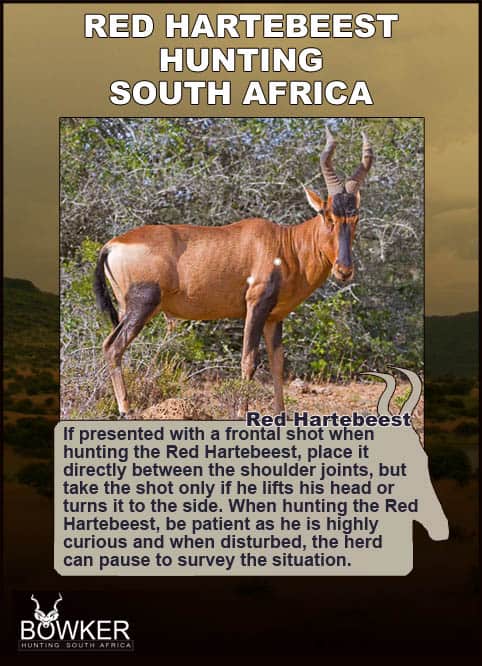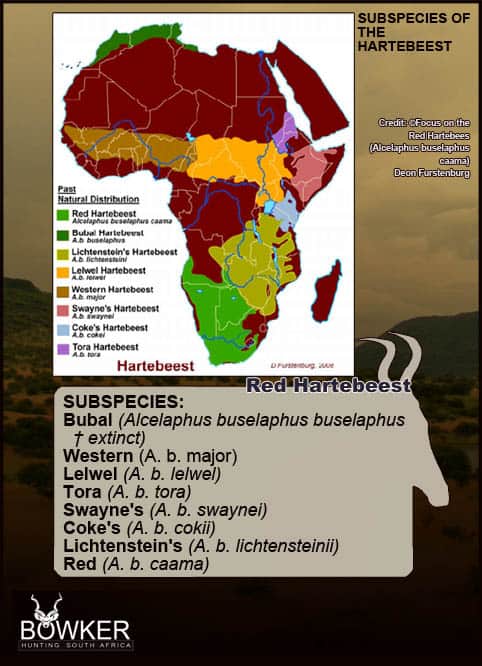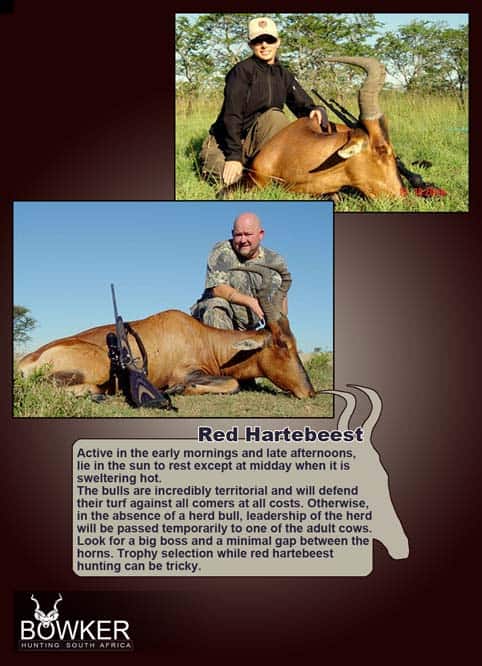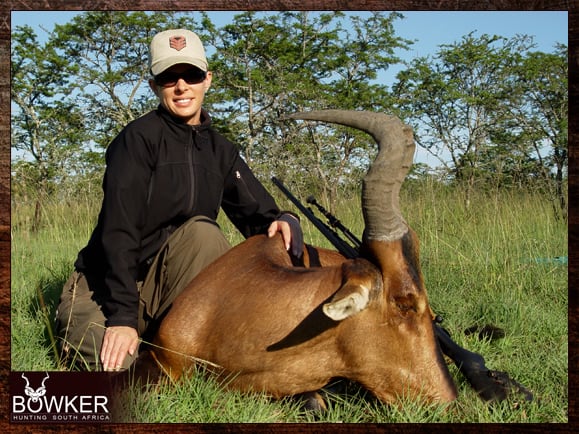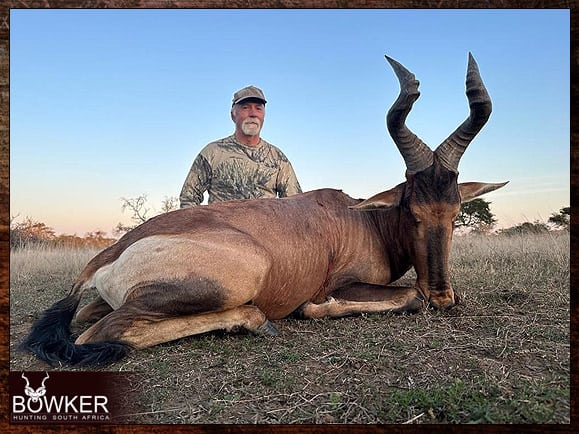
Summary
Be patient while Red Hartebeest Trophy hunting; he can be inquisitive, and even after being disturbed, the herd will often pause to mill around and survey the situation.
His fatal mistake – take the shot.
There are no seasonal restrictions on Trophy Red Hartebeest hunting in Eastern Cape, South Africa.
Nick Bowker Hunting offers trophy Red Hartebeest African hunting trips year-round.
Join us for an African hunting safari and a trip of a lifetime.
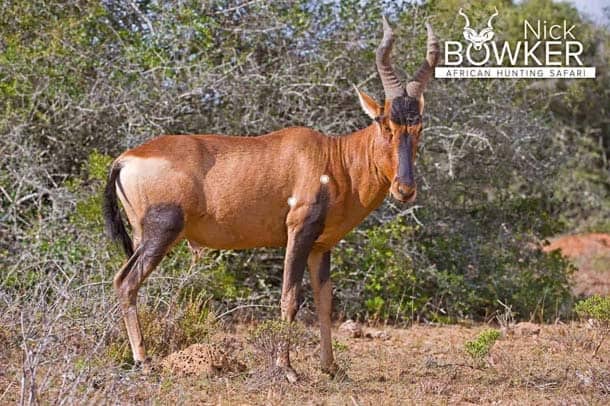
Table of Contents
- Red Hartebeest Hunting Cost
- Red Hartebeest Trophies
- Trophy Judgement and Rifle Caliber
- Difference between Male and Female
- Interesting Facts
- About the Red Hartebeest
Red Hartebeest Hunting Trophy Hunting Fees
The average price of a Red Hartebeest African safari is $1200. Red Hartebeest is included in some of our hunting packages and is value for money to any Africa hunting trip cost.
The Red Hartebeest trophy hunting package includes a licensed hunting guide and a hunting license, and all permits.
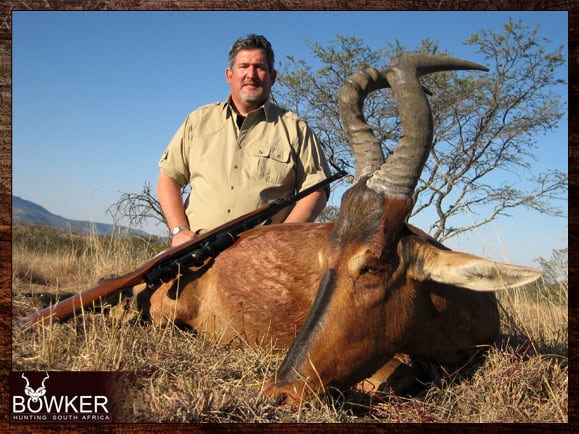

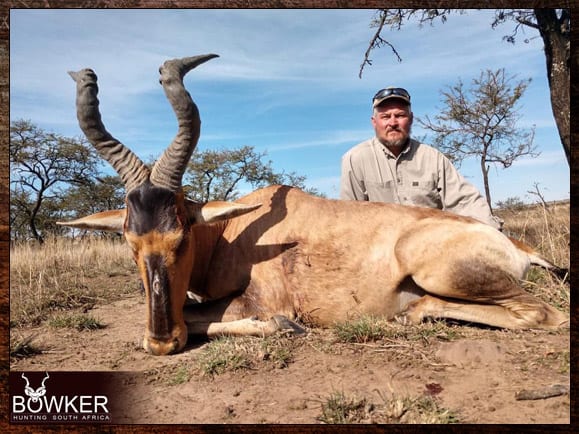
Hunting Red Hartebeest in South Africa
Shot placement must be in the bottom third of the animal directly above the front shoulder. This will ensure a heart or lung shot. Avoid head and neck shots, which are high-risk.

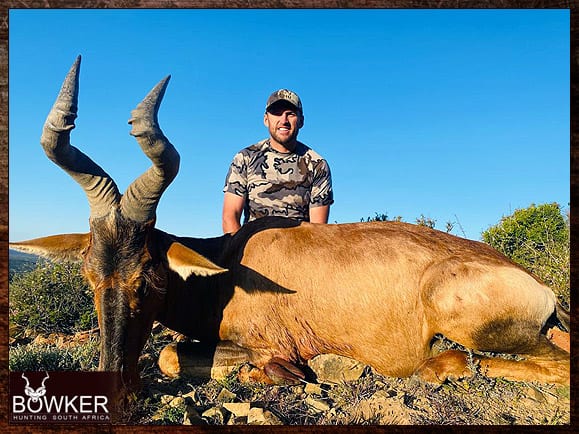
Your Red Hartebeest trophy should have an average shoulder height of around 48 inches. Weigh about 350 pounds and have a Horn Length of approximately 22 inches.
The Safari Club International minimum score for a Red Hartebeest is 62. The trophy is measured by adding the length of each horn and the circumference of the bases.
The Hartebeest is one of the fastest plains game species in Southern Africa.
In some areas, Red hartebeest can be incredibly wary and alert when being hunted.
Primarily a grazer, he is partial to ‘red grass. He will sometimes browse on leaves and drink when water is available.
Being gregarious, they form herds of up to 20 animals. Different herds are made up of territorial males: Harem herds, bachelor herds, and solitary males.
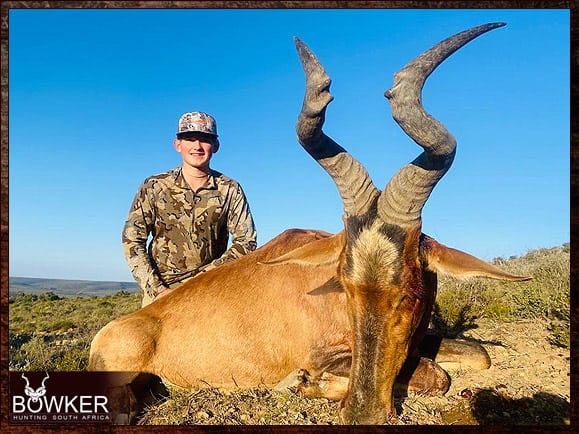
Harem herds are stable. They consist of a territorial male as the leader, young males, females, and offspring.
Active in the early mornings and late afternoons. They lie in the sun to rest except at midday when it is sweltering.
The bulls are incredibly territorial and will defend their turf at all costs. In the absence of a herd bull, leadership of the herd will be passed temporarily to one of the adult cows.
Hartebeest will mostly be found in savanna areas. They avoid dense bushveld.
They are primarily grazers and are partial to red grass. However, they will sometimes browse leaves. He drinks when water is available.
Red hartebeest hunting occurs across most of South Africa and is nicknamed the “Harley Davidson” because of its horns.
Trophy Judgement and Rifle Caliber for Hartebeest Hunting
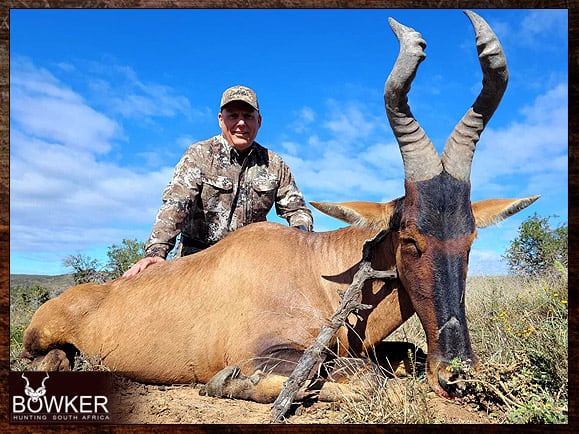
When hunting the red Hartebeest, be patient as he is inquisitive. When disturbed, the herd can pause to survey the situation.
His fatal mistake – take the shot.
The Hartebeest has a strong herd instinct. Forming herds of more or less 20. Though herds numbering in the hundreds are not uncommon.
Mature bulls will stand out in the herd. Their shoulder height is much higher than the cows and young bulls. Mature bulls have a darker, richer color, which intensifies with age.
Look for a big boss and a minimal gap between the horns.
Often, the bosses will be closed off, making skinning a difficult task.
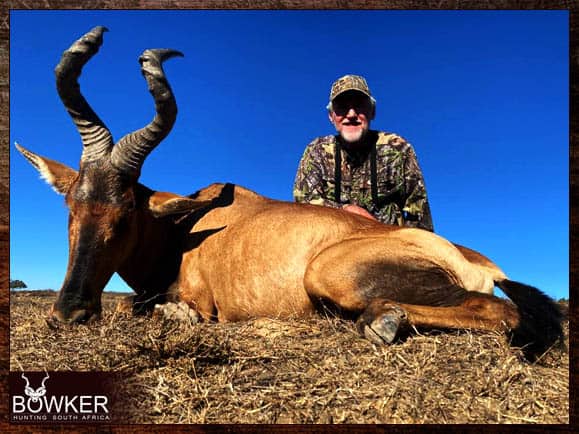
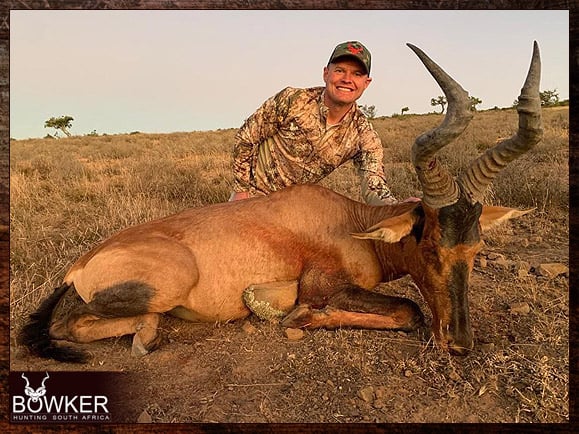
Hunting red hartebeest will demand an excellent flat-shooting rifle because distances may be a bit longer, so we recommend the 7mm or 300 magnums.
For those hunters who wish to avoid going through the red tape of bringing a rifle into South Africa, Nick Bowker has 300 Winchester Magnums fitted with suppressors.
Furthermore, the rifles include Swarovski tactical scopes. Also, we have hand-loaded Hornady ELD-X 200-grain ammunition.
This setup, including ammunition, is available as part of all hunting packages free of charge.
Be careful of the ‘humped withers’ when hunting red Hartebeest, as they have caused more than one experienced hunter to shoot too high.
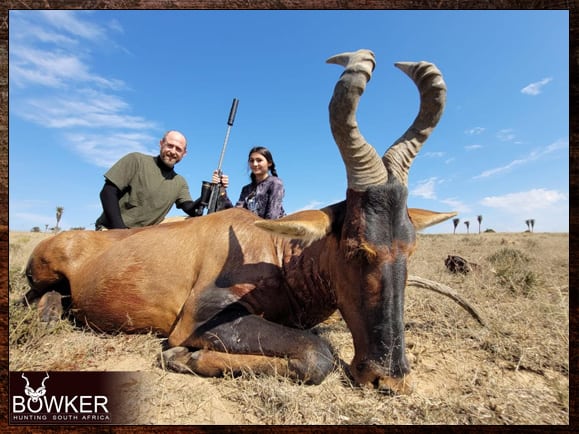
Difference between a male and female game
Both males and females have horns. However, males have thicker and heavier horns. Also, the male is even bigger with a more pronounced neck.


Interesting facts for hunts

- The name hartebeest could have originated from the out-of-date Afrikaans word Hertebeest, literally deer beast.
- The early Dutch settlers gave the name based on the resemblance of the antelope to deer.
- Pictorial and epigraphic evidence from Egypt suggests that Egyptians hunted hartebeest.
- Hartebeest occurs from altitudes up to 13,000 feet above sea level.
- Hartebeest has an elongated forehead, oddly shaped horns, a short neck, and pointed ears.
- Hunting all the hartebeest species, including the red hartebeest, involves travel across the African continent.
- Red hartebeest hunting makes a great add-on to one of our existing packages, for example, the kudu package
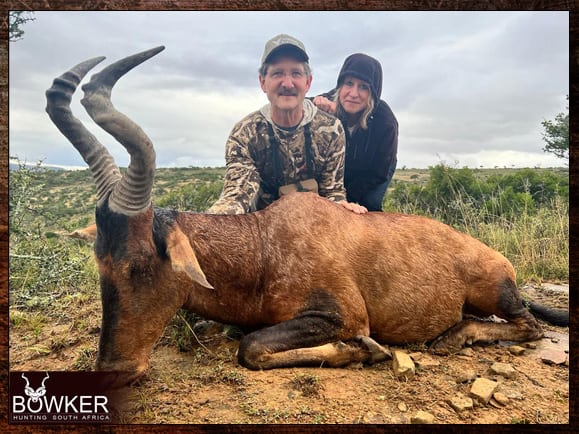
- The Hartebeest is made up of eight subspecies and includes the following:
- Northern Hartebeest,
- Red Hartebeest,
- Cokes Hartebeest,
- Lelwel Hartebeest,
- Lichtensteins Hartebeest,
- Western Hartebeest,
- Swaynes Hartebeest
- Tora Hartebeest.
- The real difference between the subspecies is in their horns.
- Red Hartebeest has Z-shaped horns.
- Lichtensteins have an S-shape.
- Swaynes and Toras Hartebeest have wide-set horns.
- Lelwels Hartebeest have a V-shape.
- Western Hartebeest has U-shaped horns.
About the Red Hartebeest
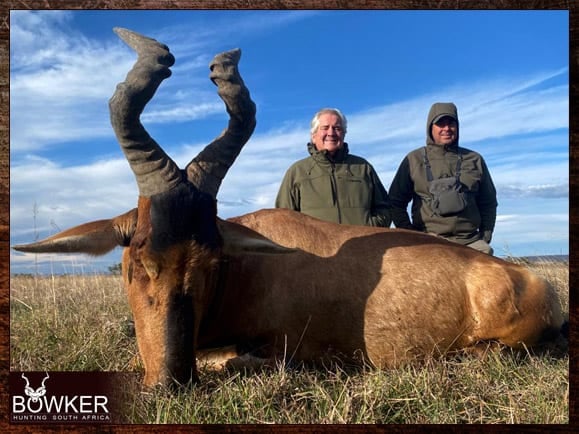
The red Hartebeest is the most colorful. Black markings contrast against its white abdomen.
It has a longer face than other subspecies. Elaborate curving horns almost join at the base.
The average weight of a male is about 300 – 400 pounds. The life expectancy of a Red Hartebeest is approximately 15 to 19 years.
There is little difference between males and females. No identifiable physical differences are visible, except the male is bigger.
Red Hartebeest is a glossy reddish-brown. The outside of the legs are black, and the tail and the blaze on the neck.
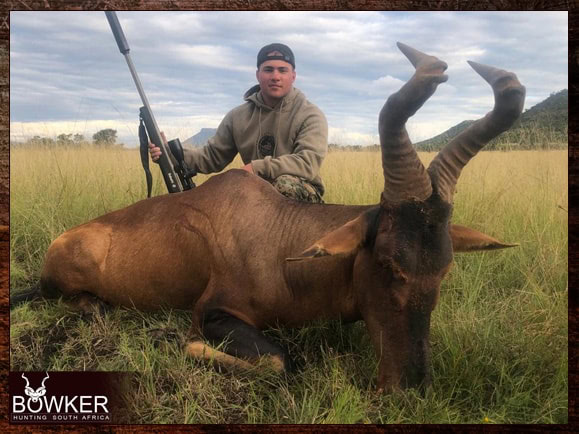
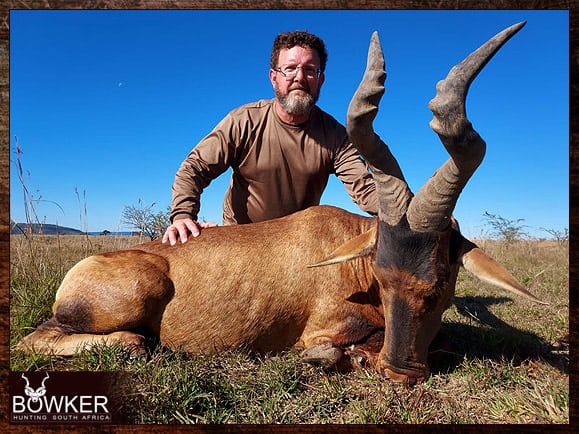
Red hartebeest trophy hunting is underrated and makes a great hunt.
The male skull weight and circumference are bigger than that of the female.
Hartebeest has an excellent sense of hearing and smell, although their sense of sight is poor.
When alarmed, Hartebeest can reach a maximum speed of 35 miles an hour. Their strategy to avoid predators is to run in a zigzag pattern. This makes it difficult for predators to catch.
Red Hartebeest is distinctive and can’t be mistaken for red lechwe or impala with similar colorations.
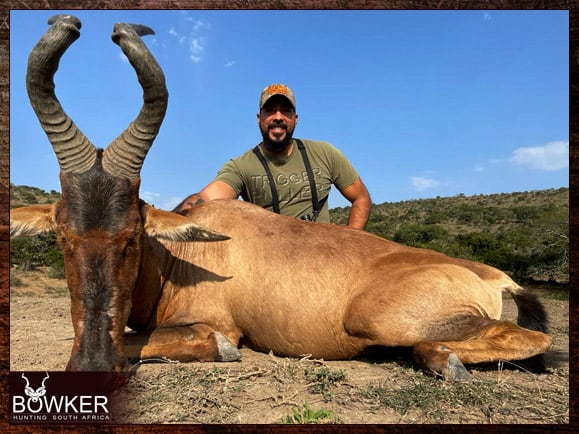
Frequently Asked Questions for your Red Hartebeest hunt
How much does it cost to hunt a Red Hartebeest?
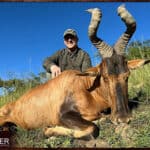
Trophy fee as a standalone Red Hartebeest are between $800 – $ 1,000. Daily rates vary between $250 to $500 a day.
Included in the Red Hartebeest trophy fee is a licensed guide. As well as a hunting license and all permits.
How to hunt Red Hartebeest?
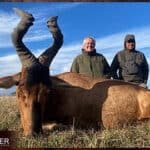
Red Hartebeest is hunted on the open plains. The Red Hartebeest is wary and difficult to approach. Longer shots will, therefore, be required.
Where do you shoot a Red Hartebeest?
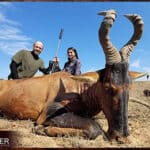
Shot placement must be in the bottom third of the animal directly above the front shoulder. This will ensure a heart or lung shot. Avoid head and neck shots, which are high-risk.
What is a trophy, Red Hartebeest?
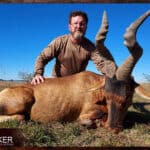
Red Hartebeest trophies have a Horn Length of approximately 21 – 22 inches. The minimum qualification score under Safari Club International for a Red Hartebeest is 62.
The trophy is measured by adding the length of each horn and the circumference of the bases.
How do you judge a Red Hartebeest trophy?
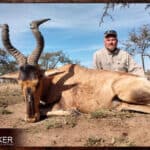
Mature bulls will stand out in the herd. Their shoulder height is much higher than the cows and young bulls. Mature bulls have a darker, richer color, which intensifies with age.
Seasonal Restrictions
When can you hunt Red Hartebeest in South Africa?

There are no seasonal restrictions on Red Hartebeest hunting in the Eastern Cape of South Africa for most outfitters.
The Red Hartebeest in Pictures
